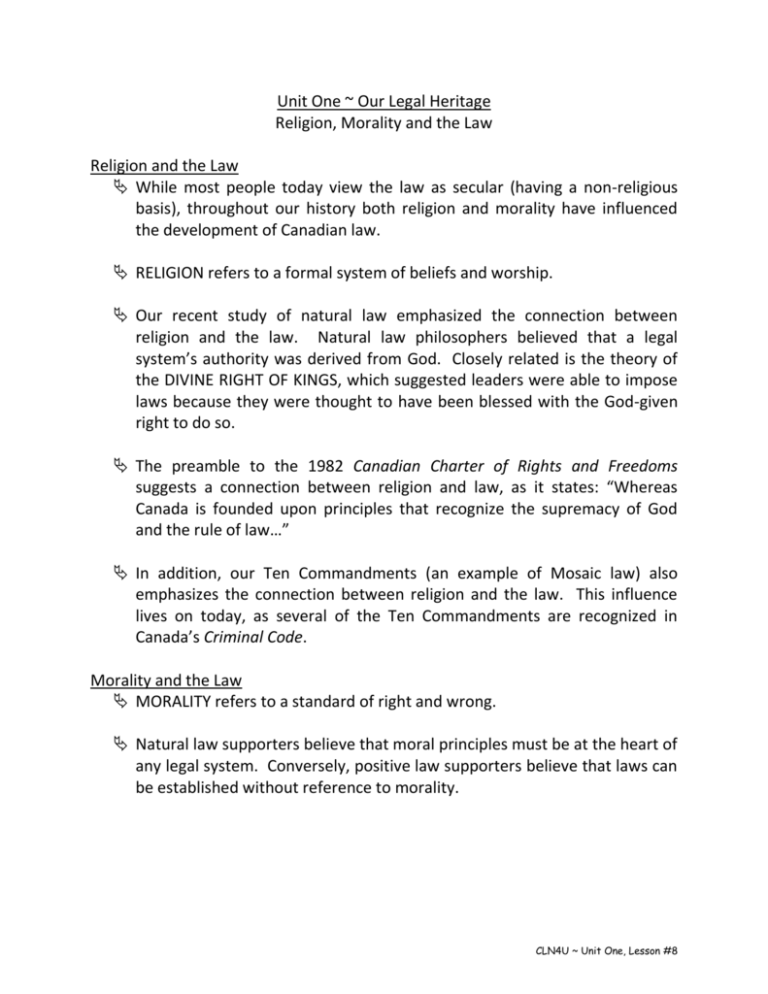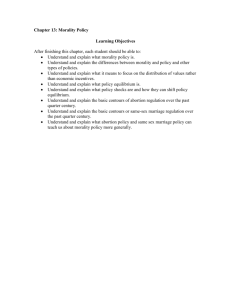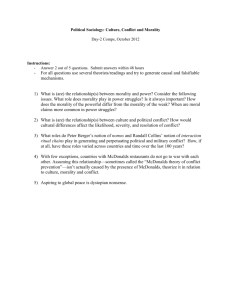
Unit One ~ Our Legal Heritage
Religion, Morality and the Law
Religion and the Law
While most people today view the law as secular (having a non-religious
basis), throughout our history both religion and morality have influenced
the development of Canadian law.
RELIGION refers to a formal system of beliefs and worship.
Our recent study of natural law emphasized the connection between
religion and the law. Natural law philosophers believed that a legal
system’s authority was derived from God. Closely related is the theory of
the DIVINE RIGHT OF KINGS, which suggested leaders were able to impose
laws because they were thought to have been blessed with the God-given
right to do so.
The preamble to the 1982 Canadian Charter of Rights and Freedoms
suggests a connection between religion and law, as it states: “Whereas
Canada is founded upon principles that recognize the supremacy of God
and the rule of law…”
In addition, our Ten Commandments (an example of Mosaic law) also
emphasizes the connection between religion and the law. This influence
lives on today, as several of the Ten Commandments are recognized in
Canada’s Criminal Code.
Morality and the Law
MORALITY refers to a standard of right and wrong.
Natural law supporters believe that moral principles must be at the heart of
any legal system. Conversely, positive law supporters believe that laws can
be established without reference to morality.
CLN4U ~ Unit One, Lesson #8
Women's Top-free Rights Entrenched in Ontario - December 1996
Author: Stéphane Deschênes ~ Source: http://www.fcn.ca/Gwen.html
On December 10th 1996, the Ontario Appeal Court reversed the 1991 conviction of Gwen Jacobs for indecency.
Jacob, at the time a university student, had walked barebreasted through the streets of Guelph in 1991 in order to
protest the inequality of the current law.
The appeal-court overturned her conviction because “There was nothing degrading or dehumanizing in what the
appellant did. The scope of her activity was limited and was entirely non-commercial. No one who was offended
was forced to continue looking at her. I cannot conclude that what the appellant did exceeded the community
standard of tolerance when all of the relevant circumstances are taken into account.”
The three judges did not completely agree on the scope of the law. They all agreed that Jacobs had not committed
an indecent act. However, Judge Osborne and Mr. Justice Allan Austin suggested that acts could be indecent
without having a sexual purpose. Judge Weiler on the other hand, believes that the question is whether an act
would be considered sexual by a reasonable bystander. She said that the exposure of breasts in our society does
not automatically mean that the act is being done for sexual gratification.
Jacob's lawyer, Margaret Buist had argued that she had a constitutional right to go topless since men could.
However, the court did not deal with the constitutionality issue in its ruling.
BACKGROUND
Gwen Jacob said she decided to challenge society's perceptions after she saw a group of men playing sports
without their shirts on a blistering hot day. The more she thought about the inequality of the situation, the more
determined she became. She said in an interview that “these were social constraints I'd challenged mentally, but
had never done so publicly.”
She was charged with indecency on July 19, 1991, the second day of walking home top-free in the city of Guelph
during 33 C weather. The police were acting on the complaint of the mother of several young children. The mother
had been concerned about the impact on her children who had seen the 19 year old student topless.
Section 173 of the Criminal Code states:
173. (1) Everyone who willfully does an indecent act
(a) in a public place or in the presence of one or more persons, or
(b) in any place, with intent thereby to insult or offend any person,
is guilty of an offence punishable on summary conviction.
After a very public trial, Jacob was found guilty of this criminal offense and fined $75. The judge didn't take
seriously her claim that women's breasts are simply fat tissue and no different than men's. The judge explained
that a women's breast is “a part of the female body that is sexually stimulating to men both by sight and touch”.
He therefore deduced that it was appropriate to restrict their public exposure.
The Ontario Court's General Division upheld the ruling. This second ruling in 1992 inspired protests across the
country including one on Parliament Hill in Ottawa. In these protests several women and
men walked topless while thousands of onlookers watched.
This is actually the second ruling acquitting women of indecency when bearing their breasts. At one of the 1992
protests in Waterloo, Ontario, five women and a teenager were arrested for bearing their breasts in public. Judge
McGowan acquitted them by saying that today's society could deal with women exposing their breasts as long as it
wasn't part of lewd or sexually erotic behaviour.
IMPLICATIONS
With two acquittals as precedent, one from the Ontario Appeal Court, it seems clear that the current law is now
CLN4U ~ Unit One, Lesson #8
unenforceable.
Jacob's lawyer, Margaret Buist said “women now have the right in this province to do the same thing that men do:
Walk down a street top-free on a hot summer's day.” She further said that women can now go topless on beaches,
in public parks, or while walking to the store without fear of being arrested.
The Toronto Sun reported that “Metro Police said that if thousands of women decided to let it all hang
CLN4U ~ Unit One, Lesson #8
out, they'd abide by the court's ruling.” Sgt. Barry Brenham who patrols Toronto's beaches said “If the court says
it's acceptable behaviour then it's acceptable - case law is the law.”
Acting Inspector Mike Sale suggested to the Toronto Sun that they have better things to do than
force women to keep their tops on. He said “If it's the will of a number of people to do something the courts have
found to be lawful then police won't focus on it.”
Southam news went on to say that while the ruling was technically only binding in Ontario, it could carry some
weights in the courts of other provinces.
Ontario's Attorney General, Charles Harnick, said that unless the crown appeals the conviction, the law prohibiting
women from going bare-breasted no longer exists. Harnick has 30 days to file an appeal to the Supreme Court of
Canada but says he will be reviewing the case and consulting crown attorneys before making that decision.
YOUR TASK
Taking into consideration our study of morality and the law, please complete the following questions:
1.
Does the Ontario Court of Appeal’s decision support the natural law or positive law position concerning
the connection between morality and the law? Explain.
2.
Write a paragraph response outlining whether you agree or disagree with the Ontario Court of Appeal’s
decision in this case. Be sure to include in your response consideration of the relationship between
criminal law and morality.
CLN4U ~ Unit One, Lesson #8






